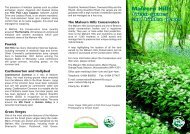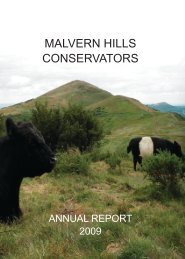Footpath degradation of the Malvern Hills - Malvern Hills Conservators
Footpath degradation of the Malvern Hills - Malvern Hills Conservators
Footpath degradation of the Malvern Hills - Malvern Hills Conservators
Create successful ePaper yourself
Turn your PDF publications into a flip-book with our unique Google optimized e-Paper software.
Stephen Britnell<br />
<strong>Footpath</strong> <strong>degradation</strong> <strong>of</strong> <strong>the</strong> <strong>Malvern</strong> <strong>Hills</strong><br />
When considering footpath morphology, three factors were considered. They were,<br />
overall path width, width <strong>of</strong> bare ground, at <strong>the</strong> depth to which <strong>the</strong> path is gullied. The area <strong>of</strong><br />
cross-section was considered, but proved difficult to interpret, possibly because path width is<br />
determined by recreational factors, and path depth more by geomorphological factors. In<br />
addition, each site was categorised as being actively eroding or not. This was done in <strong>the</strong><br />
basis <strong>of</strong> <strong>the</strong> following observations, earth, stones, spilled onto adjacent vegetated areas,<br />
recent water gullying, skid marks and o<strong>the</strong>r boot scars on turf, collapsed turf masses, recent<br />
bank collapse, absence <strong>of</strong> lichen or moss cover at <strong>the</strong> path sides, and frost heave mounds at<br />
<strong>the</strong> sides <strong>of</strong> <strong>the</strong> paths.<br />
Coleman (1981) results found that, morphological measures depend on <strong>the</strong> square<br />
root <strong>of</strong> <strong>the</strong> recreation pressure variable and <strong>the</strong> square root <strong>of</strong> <strong>the</strong> path slope. He also<br />
concluded that <strong>the</strong> maximum path depth represents incisions much as by water erosion as by<br />
feet, and that soil type appears to play a small role. Incision is high on paths running across<br />
steep slopes collecting large amounts <strong>of</strong> run<strong>of</strong>f and through flow water, which is channelled<br />
along <strong>the</strong> path. With respect to slope angle Coleman (1981) found that erosion is limited on<br />
low angle slopes, but increases rapidly on slopes above 15 degrees, a threshold slope <strong>of</strong> 7-18<br />
degrees appears to distinguish <strong>the</strong> active from <strong>the</strong> stable paths.<br />
Coleman (1981) has produced a good study <strong>of</strong> path erosion, not only quantifying <strong>the</strong><br />
phenomenon but also contributing to <strong>the</strong> understanding <strong>of</strong> causal factors, and threshold limits<br />
<strong>of</strong> path erosion, only if <strong>the</strong>y appear applicable to <strong>the</strong> local region studied.<br />
The paper by Garland et al. (1985) an approach to <strong>the</strong> study <strong>of</strong> path erosion in <strong>the</strong><br />
Natal Drakensberg, a mountain wilderness area, attempts to investigate fundamental<br />
relationships and to provide basic data on paths in Giant Castle Reserve. Garland et al.<br />
(1985) bases <strong>the</strong> factors affecting path erosion on <strong>the</strong> previous conceptual model developed<br />
by Coleman (1981). (See Figure 3). Garland agrees with Coleman that user intensity and path<br />
slope are critical variables affecting path erosion positively. Garland also suggests that site<br />
factors imparting resistance to erosion include both, vegetation, and soil type.<br />
9





